- Help inform investment decisions
- Enable the business to plan / budget more effectively
- Prevent failures
- Reduce downtime
- Prolong hardware life
- Improve user productivity
- Save time and money
It’s important however that the entire IT department isn’t just employed to keep the lights on, easily said when the issue of today may well take precedent over anything else.
Time does need to be spent ensuring that the technology framework that supports the business caters for the needs and direction of the business. In many respects the IT strategy should be the business strategy. Whilst its widely accepted that prevention is better than the cure, delivering on that end to end comes with its own set of challenges. The conversations that we have had with clients over the course of the last 12 months, (but in reality it’s been a common theme for years) suggests that getting headcount for additional staff is a challenge, if there is headcount – finding people with the right skillset can be a difficult and we’re hearing consistently that internal resources need to add value beyond keeping the lights on.
Its perhaps why the managed service / outsourcing market is so buoyant at the moment; employing partners that have already invested in the right tools and have mature incident management procedures solves some if not all of those challenges. Providing these sort of services and being at the heart of IT operations is a thoroughly enjoyable and rewarding place to be, especially when you can reflect with the wider team about what its enabled them to deliver back to the business.

About the Author: Mike Starnes
Mike has worked in the IT Industry for over 20 years. If he's not talking technology, he'll be reading, playing football or trying to embarrass his daughters.



